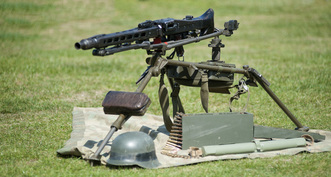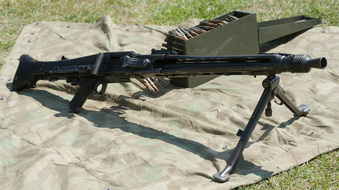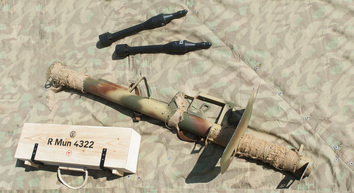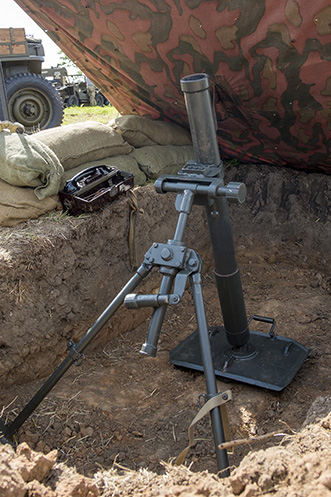1./ Kompanie Heavy Weapons
 MG42 in "heavy" role mounted
on a Lafayette Tripod
Maschinengewehr 42, or "machine gun 42" also known as the MG42, and sometimes incorrectly referred to as a Spandau, was a 7.9mm general purpose machine gun. Developed in Nazi Germany it entered service with the Wehrmacht in 1942 it supplemented, and to some degree replaced the MG 34 though both weapons were manufactured and used until the end of the war.
A very reliable, simple and easy to operate weapon the MG 42 has one of the highest average rates of fire of any single-barreled man-portable machine gun: between 1,200 and 1,500 rpm, which results in a distinctive muzzle report giving rise to its nickname "Hitler's Buzzsaw"  MG4 in "light "role with bi-pod mounted at the front
Maschinengewehr 42, (MG42) This outstanding and versatile weapon operated in a number roles within the German army of World War two. When removed from it Lafayette tripod and fitted with a bi-pod at the front it became a Light Machine gun, weighing in at 11.6 kg in light role, with bi-pod, it was lighter than its predecessor the MG 34. The bi-pod was the same one used on the MG 34,and could be mounted to the front or the centre of the weapon depending on where it was being used. There were other automatic weapon designs with similar fire-power to the MG42 but the MG 42's belt-feed and quick-change barrel system gave it the advantage. The MG 42 has lived on beyond its Nazi past. It was adopted by a number of armed organizations after the war, and was both copied and built under licence. The MG 42 was the basis for the almost identical MG1, subsequently evolving into the MG1A3, followed by the MG 3 and it lent many design elements to the US M60.

Panzerschreck the literal literal translation is "armour fright" or "tank fright".It was popularly known as Ofenrohr or "stove pipe"
but was officially the Raketenpanzerbüchse "Rocket tank rifle" or RPzB. The weapon is an 88 mm reusable anti-tank rocket launcher developed during World War II, designed as a lightweight infantry anti-tank weapon. The Panzershreck was shoulder-launched weapon which fired a fin-stabilized rocket with a shaped charge warhead. Versions of the Panzerschreck rocket could penetrate over 200 mm of armour and one direct hit would usually destroy any Allied armoured vehicle. It was so effective that Panzershrecks with well-trained crews became the bane of Allied armoured units. Their answer was to try and add improvised protection to their vehicles. Its not unusual to see photographs of tanks with, sandbags, spare tracks or logs fastened to them but most of this makeshift protection only overworked the vehicle's engine, transmission, and suspension. Allied troops preferred to use captured Panzerschrecks over Bazookas against Axis armoured vehicles, but they also needed to capture the ammunition which presented the problem of a limited supply of warheads. The Panzershrecks success in combat caused the Bazooka to be completely redesigned at the close of World War II. A larger, 3.5 in (90 mm) model was adopted, the M20 Super Bazooka. Though bearing a superficial resemblance to the Panzerschreck, the M20 had greater effective range, penetrating capability and was nearly 20% lighter than than the Raketenpanzerbüchse |



